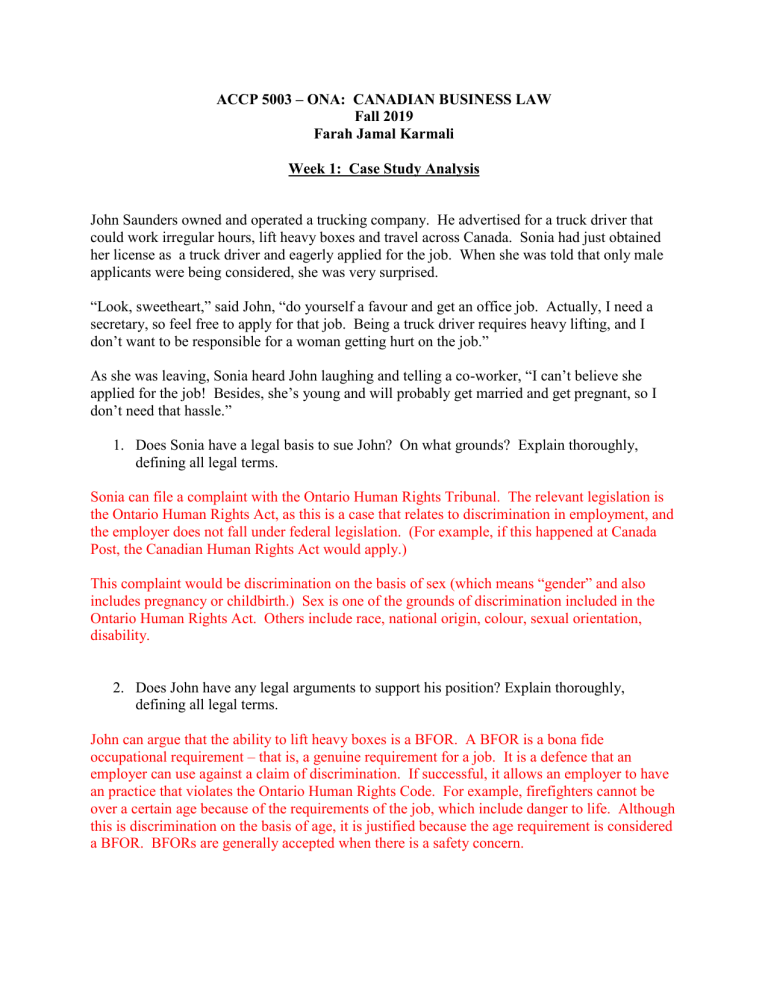Canadian Business Law: Case Study Analysis - Employment Discrimination
advertisement

ACCP 5003 – ONA: CANADIAN BUSINESS LAW Fall 2019 Farah Jamal Karmali Week 1: Case Study Analysis John Saunders owned and operated a trucking company. He advertised for a truck driver that could work irregular hours, lift heavy boxes and travel across Canada. Sonia had just obtained her license as a truck driver and eagerly applied for the job. When she was told that only male applicants were being considered, she was very surprised. “Look, sweetheart,” said John, “do yourself a favour and get an office job. Actually, I need a secretary, so feel free to apply for that job. Being a truck driver requires heavy lifting, and I don’t want to be responsible for a woman getting hurt on the job.” As she was leaving, Sonia heard John laughing and telling a co-worker, “I can’t believe she applied for the job! Besides, she’s young and will probably get married and get pregnant, so I don’t need that hassle.” 1. Does Sonia have a legal basis to sue John? On what grounds? Explain thoroughly, defining all legal terms. Sonia can file a complaint with the Ontario Human Rights Tribunal. The relevant legislation is the Ontario Human Rights Act, as this is a case that relates to discrimination in employment, and the employer does not fall under federal legislation. (For example, if this happened at Canada Post, the Canadian Human Rights Act would apply.) This complaint would be discrimination on the basis of sex (which means “gender” and also includes pregnancy or childbirth.) Sex is one of the grounds of discrimination included in the Ontario Human Rights Act. Others include race, national origin, colour, sexual orientation, disability. 2. Does John have any legal arguments to support his position? Explain thoroughly, defining all legal terms. John can argue that the ability to lift heavy boxes is a BFOR. A BFOR is a bona fide occupational requirement – that is, a genuine requirement for a job. It is a defence that an employer can use against a claim of discrimination. If successful, it allows an employer to have an practice that violates the Ontario Human Rights Code. For example, firefighters cannot be over a certain age because of the requirements of the job, which include danger to life. Although this is discrimination on the basis of age, it is justified because the age requirement is considered a BFOR. BFORs are generally accepted when there is a safety concern. In this case, it is unlikely that the John would be successful in arguing that he can only hire men because the job requires heavy lifting. He would have to give every candidate – male or female – the opportunity to demonstrate that they can do the job. 3. What remedies would Sonia seek? She would likely seek damages (a monetary award that compensates her for her losses), and could seek an order allowing her to apply for the job. (From a practical perspective, she may not want to work there anymore, and even if she does, it may be difficult to work there after the employer has been “forced” to hire her.) She may also ask for an order that requires John to adopt a special program to promote hiring women in his company, but this is more likely in a large company.



